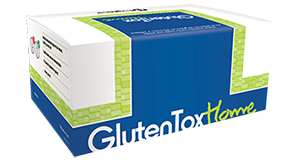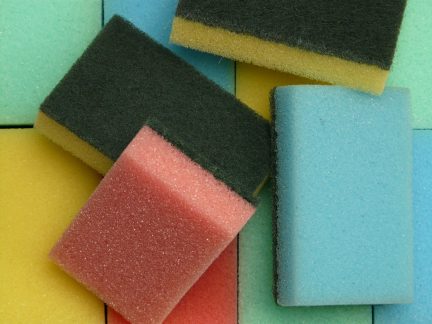Sometimes our customers tell us that using GlutenTox Home to check foods or drinks for gluten contamination makes them feel like they’re back in their high school chemistry labs – spoons, and pipettes, and vials oh my! We know the kit can seem a little overwhelming, but we promise: the steps aren’t hard – they just take a little attention. What’s more, there is an important reason behind each and every instruction in the GlutenTox Home kit. In order to get accurate results about how much gluten might be in a food, it’s absolutely key to follow the instructions closely. Today we’re going to explain the reasons behind each step of the GlutenTox Home manual.
Instead of reviewing the manual step by step, though, let’s meet your imaginary neighbors, who baked you some gluten-free sugar cookies.
 So nice of them, right? They remembered that you’re gluten-free and made you something special.
So nice of them, right? They remembered that you’re gluten-free and made you something special.
You thank them gracefully but these cookies put you in a pickle. Should you eat them? Do your neighbors really understand how to safely bake gluten-free? Good thing you have a GlutenTox Home kit in your cabinet.
Let’s imagine they did almost everything right. Clean kitchen, safe gf ingredients, etc. But: a few months ago one of them used the same spoon for flour and then baking powder. There’s still a little trace of contamination in the box.
Are these cookies gluten-free?
For the sake of this article, let’s decide that the cookies have about 15ppm gluten because of cross-contamination in the kitchen. So, while they are not gluten-free, they are extremely low in gluten. The cookies are safely under the FDA limit, and in theory should be safe for most people who avoid gluten – but we know that some people prefer to avoid ANY detectable gluten at all. If you are going to the trouble of using a gluten test kit, you might as well get an accurate answer about the level of gluten in these cookies, right?
What can GlutenTox Home tell me about these cookies?

Because GlutenTox Home lets you adjust the test sensitivity, you will get different answers at different levels of detection. If you’re very sensitive to gluten and you choose to test for gluten at the 5ppm threshold, you’ll see a positive result. You probably do not want to eat these cookies! If you test to 20ppm, the FDA guidelines, you will see a negative result – the cookies have less than 20ppm gluten. Someone is going to be eating cookies for breakfast!
Is the test still accurate if I don’t follow the instructions?
GlutenTox Home is designed to provide accurate, consistent, repeatable results – but this requires following the instructions. Here are some important ways that your results can be affected by inconsistent test methods:
1. You forgot to wash your hands.
You shook your neighbors’ hands, of course, but what you didn’t realize is that they came over straight after eating some sandwiches. Just because you can’t see the crumbs doesn’t mean they haven’t transferred a little bit of gluten onto your hands – the same hands you’re going to use to crumble up a cookie. Is it enough contamination to tip your results over from negative to positive? Tough to say, but there’s an easy way to avoid it: wash your hands first!
2. You didn’t measure your sample carefully.
With clean hands, you break apart a cookie onto a paper plate. You eyeball a crumb that looks – to you – to be about the size as the provided spoon in the kit. You drop it into the extraction solution, and continue testing.
What happens if you over-estimated and used more cookie than needed? Your 5ppm test results will not change: positive. But your 20ppm test could appear positive even though the cookies only have 15ppm. By increasing the sample size, you decrease the threshold of the test. Accurate results require that you test the correct amount of food.
Let’s think about this another way, with golf as an example. You and your buddies played 9 holes, and without realizing it you compare scores with someone who played the full course. “Wow!” you think, “What a really terrible golfer, such a high score for only 9 holes.” That person isn’t really a terrible golfer; they just put more time in on the course.
2a. What if your sample is too small?
In a hurry, you don’t put in enough cookie crumbs. In this case your 20ppm test will stay the same: negative. Your 5ppm test, though, might also look negative, even though the cookies have 15ppm gluten. If we’re back on the golf course, this is the opposite situation. You and your buddies play the full 18 hole course, and you compare scores with someone who only played the back 9. “Holy moly!” you think again, “I better get this person on my team for the tournament, what an amazing player!”
In both golf games, you aren’t comparing apples to apples. You can’t actually know who is the “better” golfer. It’s the same with the test: the GlutenTox test strip is calibrated carefully to give accurate results based on 1 gram or 1 milliliter of sample. The test strip doesn’t know how much cookie you actually used – it doesn’t have a way to adjust itself up or down based on your actions.
What would happen if you ran two tests on the same cookie, one with half a gram and one with two grams of crumbs? If you guessed, “you could get two different answers,” you are absolutely correct!
Once again, there’s an easy fix: Use the provided spoons and the chart in the manual to determine the correct number of level spoonfuls you’ll likely need to approximate 1g or 1mL of sample. Even better, use a digital scale to measure the sample weight.
Remember: If a test kit doesn’t require a specific, measurable, sample size, it cannot accurately measure the gluten present in your sample.
3. You don’t take a representative sample.
If the cookies are plain sugar cookies, you can’t mess this up. But what if they have frosting? If so, you have a choice to make: you can run one test on the cookies and another test on the frosting, or you can make sure to include both in a single test. Either way is OK, just remember: if you don’t put it in the test, you aren’t testing it! An accurate test can only be run if your sample is an accurate representation of the food you plan to eat.
Another important area when building a representative sample: the crust! Are you worried about the cooking environment? If so, test part of the food that was exposed to countertops, baking sheets, or the air.
4. You’re in a hurry.
We promise: if we could make the test quicker, we would! Here are two tempting shortcuts that will invalidate your tests:
You must shake the sample for two minutes, to ensure that the solution can separate out out any detectable gluten from other ingredients. If you rush, the gluten could be under-represented (the test could report less gluten than is truly in the sample).
Secondly, you must wait 10 minutes before declaring a negative result. It’s tempting to “call” the food as safely gluten-free if you don’t see a pink line at 5 minutes, but this is a mistake. Sometimes a pink line will appear sooner – especially when the food is very high in gluten – but sometimes it will take the full 10 minutes required. The only way to be certain our negative results are valid is to wait the full 10 minutes.
Two caveats! If you see the pink line sooner, it’s OK to declare a positive. If you forget about the test and you check it well after the 10-minute mark, the results may no longer be valid. It’s wise to set a timer when you begin the test.
In conclusion, we know that when you first open your GlutenTox Home test kit, it can feel a little overwhelming. Once you run through the first test, we bet you’ll feel far more comfortable. If you are curious about anything in the box, or you are confused about a step in the instructions, check out our FAQ or give us a call. We’re happy to chat and we want you to test for gluten in foods with confidence in your results.

Need to test for gluten at home?
Commercial-quality, user-friendly. Clear results in less than 20 minutes.





